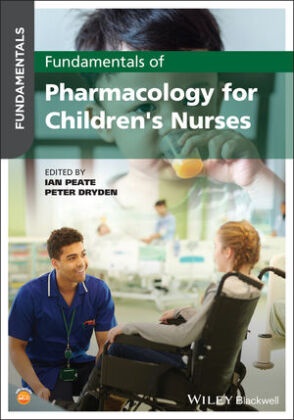Read more
Registered Nurses must have thorough knowledge of pharmacology, medicines administration, and the effects of medicines. Fundamentals of Pharmacology for Children's Nurses is written for nurses and allied health professionals involved in the care of children and young people (CYP) to focus exclusively on pharmacology. Filling a gap in current literature on the subject, this much-needed resource develops the competence and confidence required to prescribe, dispense, and administer medicines to children and young people.
Emphasising the importance of patient-centered care to CYP, the text describes the role of the healthcare provider working with CYP and their families; explains how to use pharmaceutical and prescribing reference guides; discusses legal and ethical issues; examines pharmacodynamics and pharmacokinetics, and more. Helping readers respond appropriately and compassionately to the needs of those receiving care and their families, this textbook:
* Covers a wide range of medications used in diabetes, cancer, mental health, and other areas
* Features a wealth of full-colour images and numerous pedagogical tools including learning objectives, self-test questions, and reflective exercises to enable readers to contextualise and assess their knowledge
* Presents case studies to reinforce learning, and illustrate the application of theory to practice
* Provides authoritative and practical guidance on formulations, adverse drug reactions, analgesics, antibiotics, immunisations, and the medications most commonly used when providing care to CYP
* Includes access to a companion website with interactive MCQs, case studies, references, an image bank, and links to further reading and supplemental resources
Fundamentals of Pharmacology for Children's Nurses is essential reading for undergraduate children's nursing students, trainee nursing associates, those undertaking healthcare programmes of study, as well as those seeking to better understand pharmacology.
List of contents
Contributors xv
Preface xxv
Acknowledgements xxvii
Prefixes and Suffixes xxix
Abbreviations xli
About the Companion Website xliii
1 Introduction to Pharmacology, Children and Young People 1
Introduction to Pharmacology 2
Professional Framework 2
The Importance and Value of Medicine Within Healthcare 3
Therapeutic Pharmacology 3
Social Prescribing 4
Safety Within Paediatric Care 5
Medicines Optimisation 5
Medicines 6
Medicine Management 6
Safety: Rights of Medication Administration 7
Specific Considerations for Babies, Children and Young People 7
Infancy 7
Adolescents 9
Tablets 10
Distraction Techniques 10
Conclusion 11
Glossary 11
References 12
Further Resources 12
Multiple Choice Questions 13
Find Out More 14
2 How to Use Pharmaceutical and Prescribing Reference Guides 17
Introduction 18
The British National Formulary and the British National Formulary for Children 19
Paper Copy BNFc 19
How to navigate the BNFc 19
Online and Mobile Application BNFc 23
Monthly Index of Medical Specialities (MIMS) 24
Electronic Medicines Compendium 26
What can be Prescribed on an NHS Prescription? 26
Other Guides to Prescribing 27
The Evidence Base to Prescribing: Prescribing Guidelines 28
Conclusion 30
References 30
Further Resources 30
Multiple Choice Questions 30
3 Legal and Ethical Issues 33
Introduction 34
The Law 34
The Bolam Test 35
The Children Act 2004 36
Duty of Care and Healthcare 37
Regulation of Healthcare 37
Ethical Principles and Theories 38
Research 39
Children and Young People who are under 16 years - Gillick and Fraser Guidance 42
Assessing and Promoting Competence 42
Parental Responsibility 43
Medication Adherence and Administration 43
Conclusion 44
References 45
Further Resources 47
Multiple Choice Questions 47
Find Out More 48
4 Medicines Management and the Role of the Healthcare Provider Working with Children, Young People and Families 49
Introduction 50
Being an Accountable Professional 51
Nursing and Midwifery Council 51
Employer and Colleagues 51
Promoting Health and Preventing Ill Health 52
Holistic Assessment 52
Assessing Needs and Planning Care 53
Self-Medication 55
Complementary and Alternative Medication (CAM) 58
Planning 58
Providing and Evaluating Care 58
Checking 59
Evaluation 59
Leading and Managing Nursing Care and Working in Teams 60
Improving Safety and Quality 62
Coordinating Care 63
Conclusion 65
References 65
Further Resources 66
Multiple Choice Questions 66
Find Out More 68
5 Pharmacodynamics and Pharmacokinetics 69
Introduction 70
Royal Pharmaceutical Society 70
The Nursing and Midwifery Council 70
Pharmacokinetics 70
Think Paediatrics 79
Pharmacodynamics 81
Conclusion 85
Glossary 85
References 85
Further Resources 87
Multiple Choice Questions 87
6 Drug Formulations 89
Introducti
About the author
Ian Peate, OBE FRCN is Principal, School of Health Studies, Gibraltar; Visiting Professor of Nursing, St George's University of London and Kingston University London; Visiting Professor, Northumbria University; Visiting Senior Clinical Fellow, University of Hertfordshire, and Editor-in-Chief of the
British Journal of Nursing. Peter Dryden is a Programme Lead for Children's Nursing and a Senior Lecturer, Department of Nursing, Midwifery & Health, Northumbria University, UK. He has worked on a number of National and Regional developments such as National Institute for Health and Clinical Excellence (NICE) standards for IBD.

